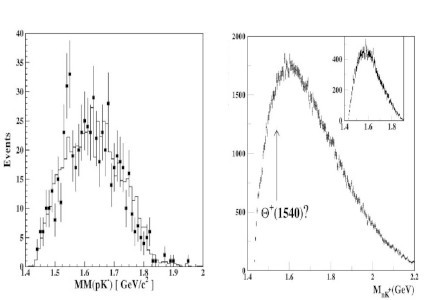Pentaquark Search

The results of one experiment using the CLAS detector at Jefferson Lab, called g10, is shown left, where the mass of the (nK+) system is shown. The old results are plotted with points, and the new results are shown as a histogram. It is clear that the peak (excess counts at about 1.54 GeV) in the older data is not reproduced in the new, higher-statistics experiment. Another experiment, also using the CLAS detector and known as g11, tried to replicate the peak seen in an earlier experiment from Germany. The result is shown at right- clearly there is no sharp peak in this mass spectrum.
Additional Links
Most known particles have either 3 quarks (baryons) or a quark-antiquark pair (mesons). The pentaquark is defined as a subatomic particle consisting of 4 quarks and one antiquark. If the pentaquark exists, then it would be a breakthrough in our understanding of how quarks can be put together to form composite particles. However, while there were claims by several experiments around the world for a pentaquark (now called the Θ+), newer, higher-statistics experiments put in doubt some of the earlier data claiming evidence for the Θ+. With better exeriments, Jefferson Lab was able to test the hypothesis that earlier experiments might have found evidence for the Θ+ pentaquark. The new data give a null result for the existence of the Θ+. This is an example of the scientific process at work; claims of new particles must be reproducible in experiments with higher statistical precision. Jefferson Lab has played a crucial role in the search for new and exotic types of subatomic particles.
K. Hicks, Prog. Part. Nucl. Phys. 55 (2005) 647
M. Battaglieri et al. (The CLAS Collaboration), Phys. Rev. Lett. 96 (2006) 042001
K. H. Hicks, hep-ex/0510067

